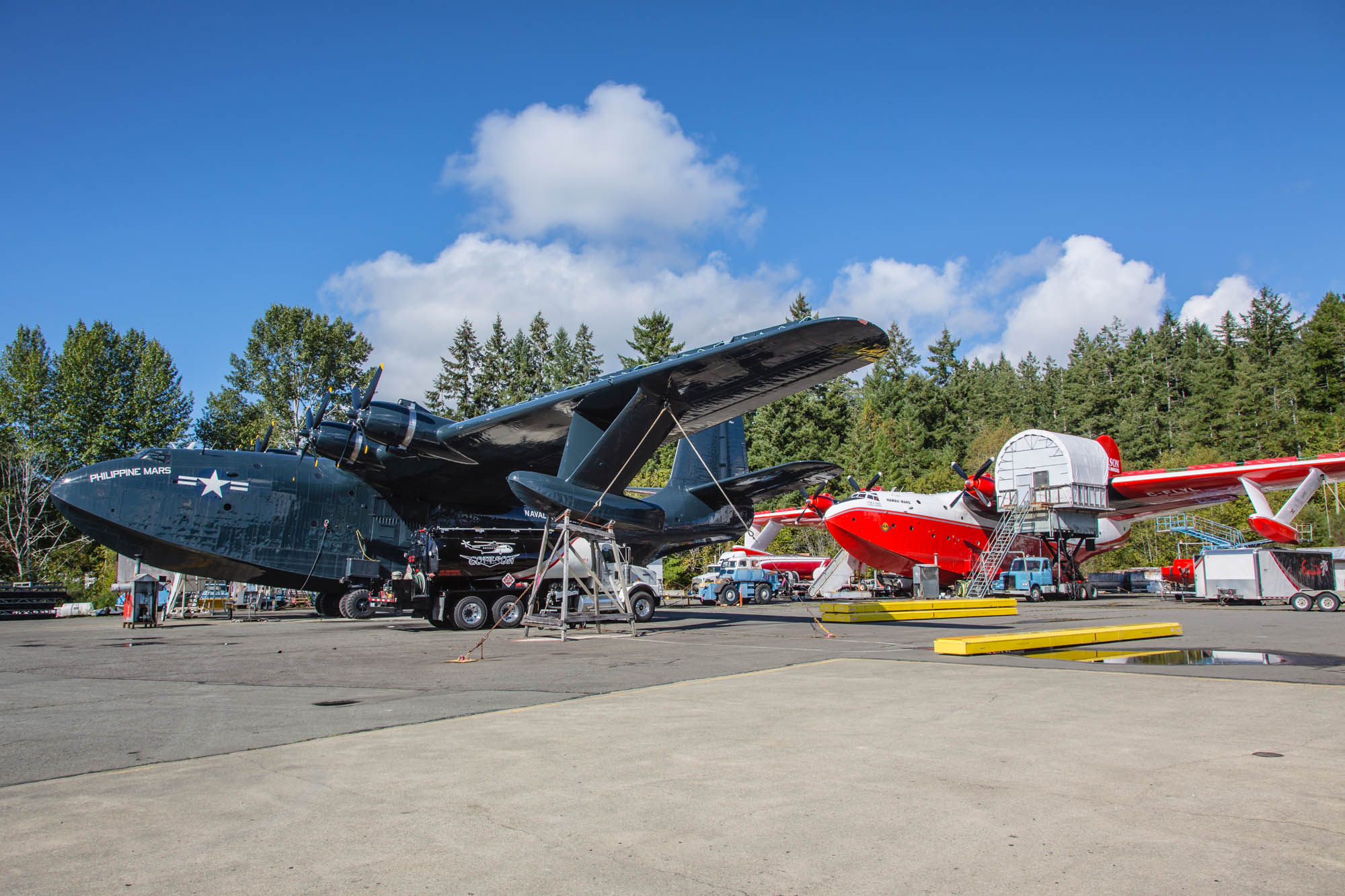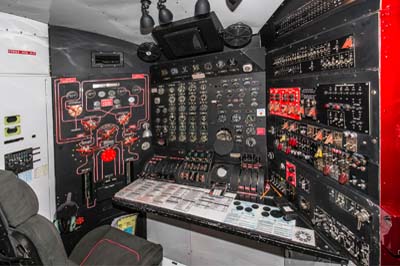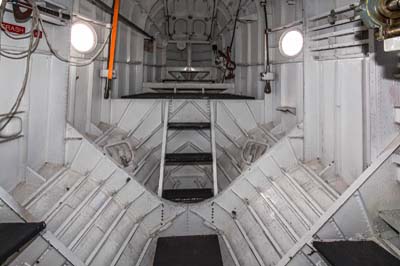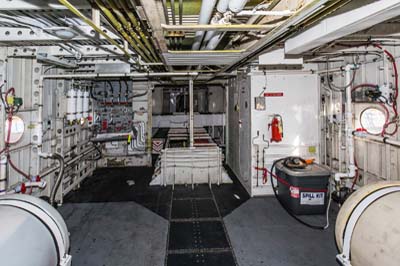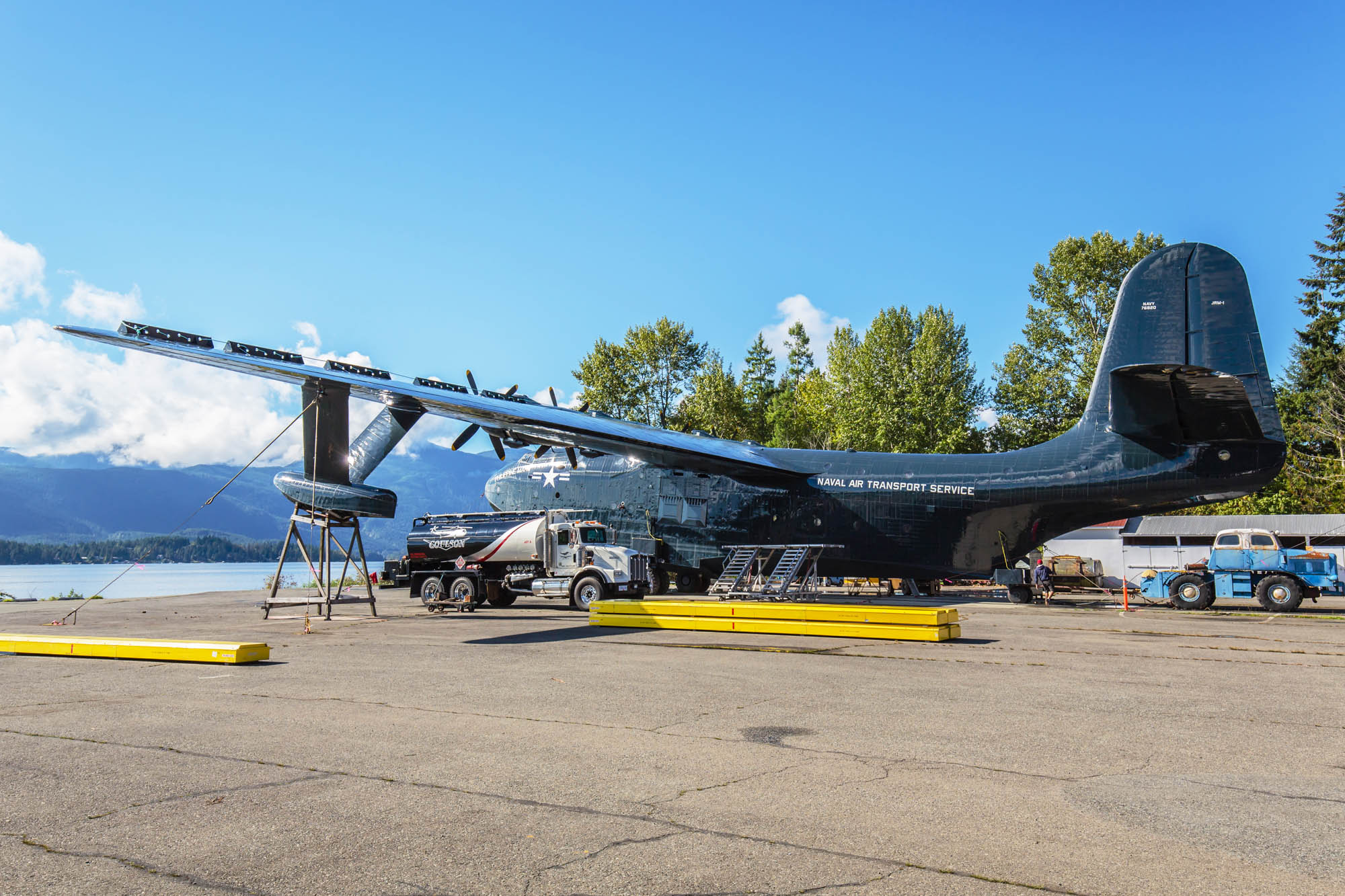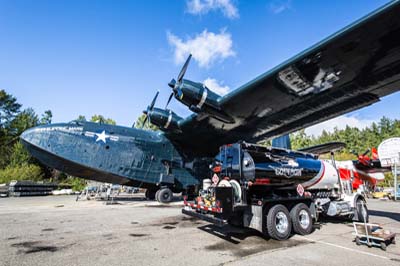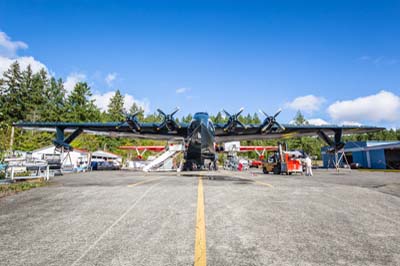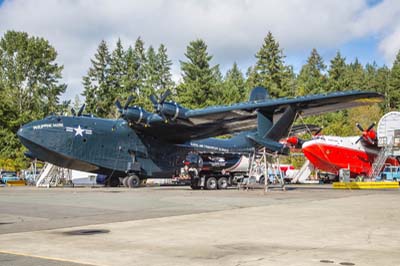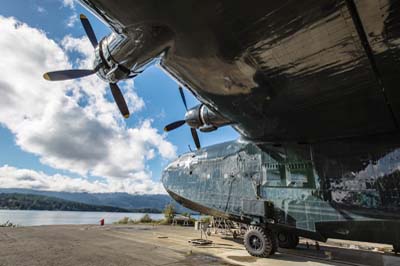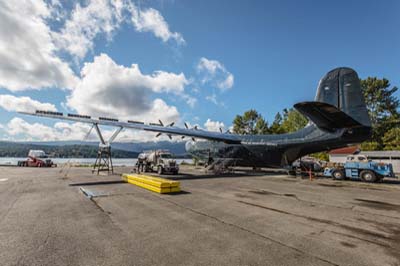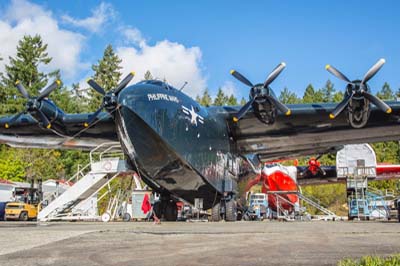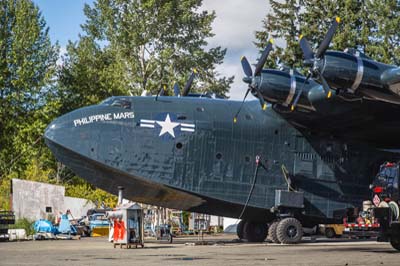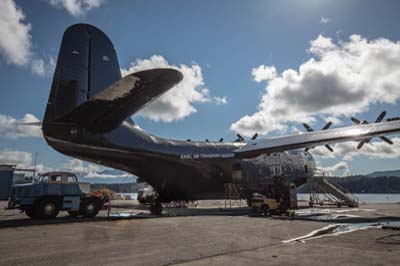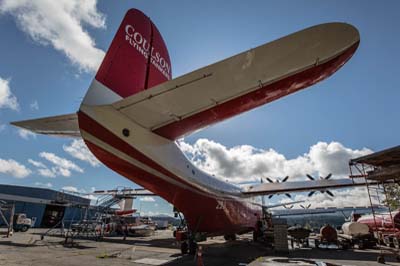Martin Mars water bomber
Sproat Lake, Port Alberni, Vancouver Island, Canada
September 2015
|
British Columbia's most loved aircraft are to be split up after 57 years
Coulson Flying Tankers own the last two flying Martin Mars fire-fighting sea planes and have agreed a deal to transfer one of their beloved old ladies to the U.S. National Naval Aviation Museum in Pensacola, Florida. The pair of Martin Mars converted water-bombers have flown from Sproat Lake near Port Alberni on Vancouver Island since 1959, dropping millions of gallons of water to save British Columbia's (BC) valuable forests from devastation by fire.
|
| The last remaining pair of Martin JRM Mars operated by Coulson Flying Tankers, Philippine Mars in its former US Navy paint scheme at the front and the Hawaii Mars in its distinctive red and white water bombing livery. Both aircraft have been taken ashore for the winter. |
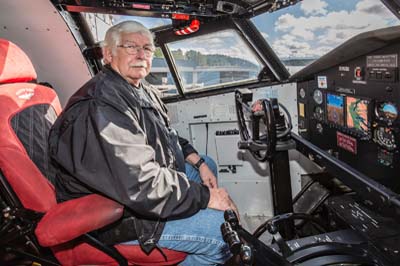 |
In the cockpit Hawaii Mars, Roy Copeland converted to the Mars in 1980, he is now Coulson's Director of Maintenance.
In 2007 under the direction of Wayne Coulson upgraded the Mars with a glass cockpit which enhanced the safety and versatility of the aircraft, with the introduction of TCAS (traffic collision avoidance system) they operate anywhere in the world. |
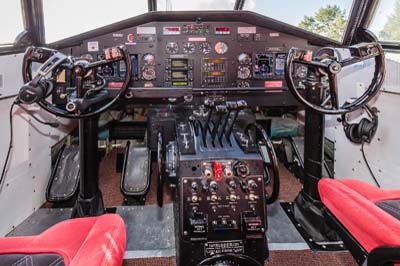 |
Hawaii Mars. There are two drop switches on the control column for the pilot on the right and one for the co-pilot on the left. The two red buttons on the control column allow for a full drop or two half-drops. If there is an electrical or hydraulic failure then the water can be released with a manual mechanism on the floor. |
The aircraft known as the Philippine Mars despite not having flown since 2012, has been kept in good flying order in readiness for a call to service. Finally the decision has been made to fly it to Florinda in the Spring 2016 where it will be put on static display at the famous US Naval museum. Coulson's recently stripped back its familiar red and white paint to reveal its original US Navy scheme which dates back to when it was delivered in 1945 and have re-applied the markings it once wore. In exchange for this valuable piece of US Naval history Coulsons are to receive two Lockheed C-130 Hercules and eight smaller aircraft which will be overhauled and sold.
Glenn L. Martin Company built the Mars for service with the US Navy during World War Two, only seven were built from 1941, one of which crashed a few weeks after its first flight. The five sold to the US Navy were originally intended as patrol bombers, however the concept was considered obsolete by the time they were delivered in 1945 and so they were utilised as transports. Each aircraft was individually named; Marianas Mars, Philippine Mars, Marshall Mars, Caroline Mars and Hawaii Mars they flew routes from the United States mainland to Hawaii and to islands right across the Pacific. By 1959 the US Navy was ready to scrap them when a consortium of British Columbia forest companies named Forest Industries Flying Tankers stepped in to buy four aircraft for conversion to water bombers with a large number of spares. Fairey Aviation at Victoria, British Columbia fitted water tanks and retractable scoops which enabled 60,000 pounds (27,216 kgs) of water to be picked up in 22 seconds while taxiing. Unfortunately Marianas Mars crashed in 1961 while fire-fighting and Caroline Mars was written off by a typhoon a year later. Hawaii Mars and Philippine Mars were only converted after the other two were lost, entering service in 1963. |
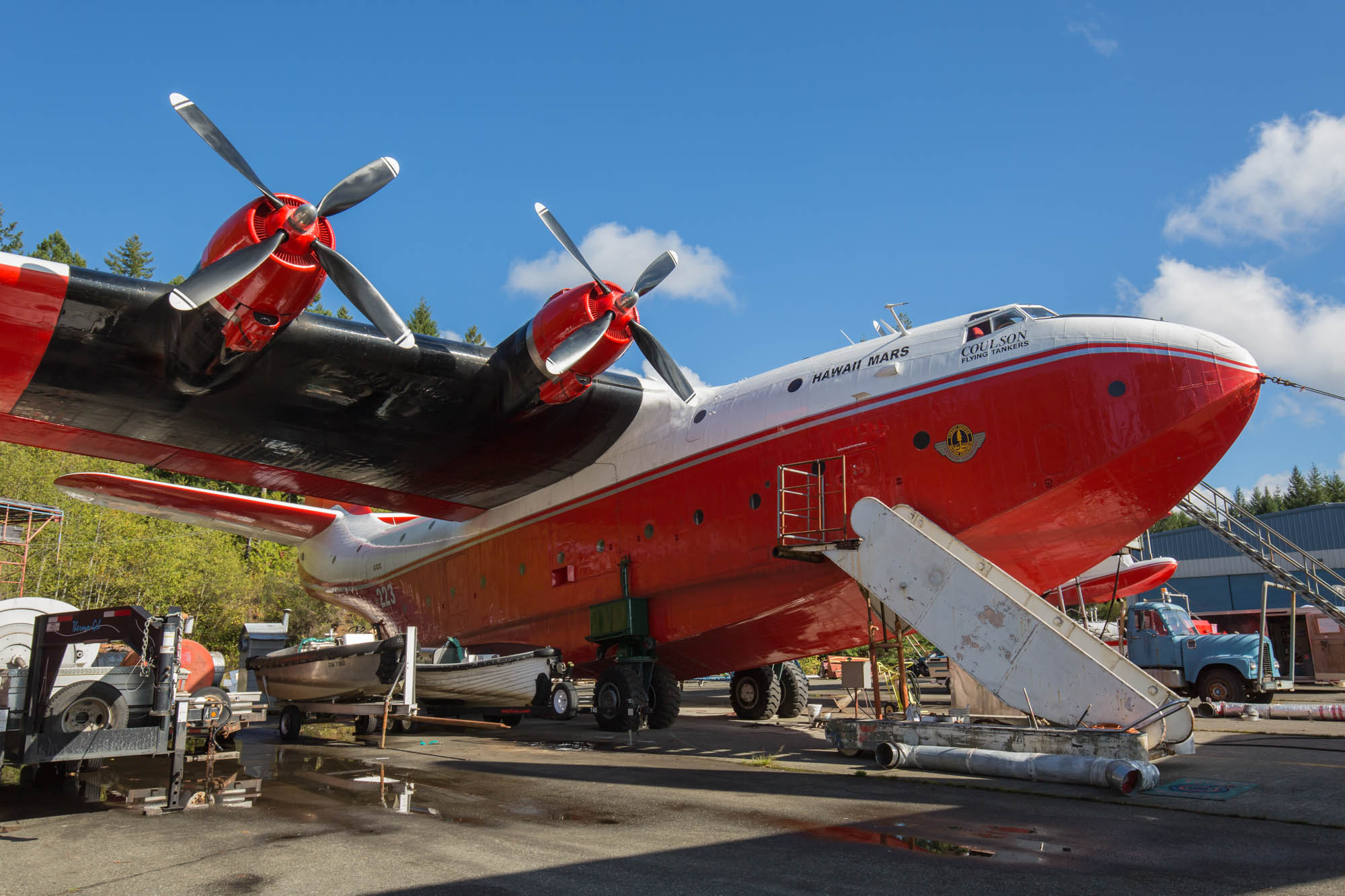 |
Martin JRM Mars named Hawaii Mars being maintained in readiness for the 2016 season.
"The beautiful thing about this aircraft is that the pilot is just flying the aircraft, he is not controlling the power, not dealing with the electrical or engine systems or propellers", explained Roy Copeland. "It's the Flight Engineer behind the pilot who is controlling those." The pilot just makes the calls according to our standard procedures for; power settings, pre-drops, after drops, pre-landing and pre-take-offs etc. "At low-level fighting fires GPS [Global Positioning Satellite for navigation] is a great tool because of the smoke masking the area" he added. |
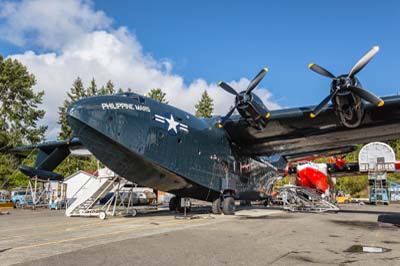 |
Up until the retirement of the Argus the engines were serviced by Bristol in Montreal before maintenance moved to Burbank California in the early 1980s. Coulsons considered buying some Lockheed Electra's and moving the turbine engines and cockpits across to the Mars but this was found to be too expensive so they stuck with the radial engines. They are now being over-hauled by Precision Engines LLC at Everett, Washington. |
The Mars rugged design and it's conversion to a water bomber, a task for which it is ideally suited, has led to its impressive longevity. Roy Copeland, Coulson's Director of Engineering, should know more about keeping these aircraft flying than any other. Originally serving with the Royal Canadian Air Force as a flight engineer on the Canadair CP-107 Argus out of nearby Comox air base, on retirement in back in 1980, he was snapped up by the aerial fire-fighting operation. He says, "The transition from the Argus to the Mars was quite simple I just had to meet the hours required by Transport Canada so I was up and running in no time at all that season. Today we have to train in house aircraft engineer graduates from scratch which can take five years as a second engineer until he becomes a flight engineer".
In 2006 after 40 years of service fighting countless fires across the province both remaining Mars were put up for sale, under the condition that when they were retired one aircraft would be donated to Port Alberni for display. Coulson Group of Port Alberni were eager to own them and agreed a purchase price in 2007 to continue flying them as water bombers.
"Seat of the pants"
Response times have always been impressive meeting BC Forest Service stipulations of; 'yellow' one hour call out, 'blue' 30 minute and 'red' immediate call out. "For 'red' we would warm up the engines on the lake first thing in the morning so when we get a call we can be in the air within ten minutes", stated Roy Copeland. "Getting to a fire early is usually key to how successful the outcome will be. This is why the Mars accomplished what it did so well for so many decades. It got out there early in the day and killed the fires before they became unmanageable", reported Port Alberni man Wayne Coulson the Coulson Group CEO.
Average drop is about 200 feet above the drop area at 200 knots. "You are getting rid of 60,000 pounds [27,216 kgs] of weight in a few seconds with each drop. To avoid damaging the aircraft you need to keep positive pressure on the wings by pushing the aircraft down to stop the nose from pitching up like crazy and the resulting negative g", explained Roy Copeland. Aircraft are designed for positive wing loading and undesirable stresses can damage the aircraft. "The pilot contends with updrafts, down-drafts, while the primary role of the co-pilot during the drop is to keep a look-out for obstacles, if he sees anything the pilot cannot react to he can quickly take the controls and release the water" he says adding, "There are no targeting devices it's all seat of the pants."
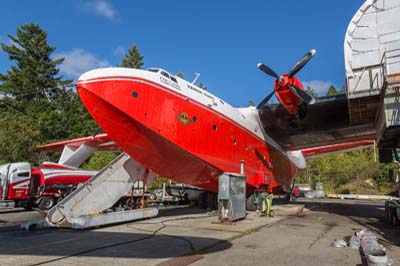 |
Hawaii Mars. The Mars is flown a little slower than more modern aircraft, the slower you fly the more effective water bombers are, it can get down to 110 knots where as a Douglas DC-10 or Boeing 747 can only go down to around 130 knots. |
Keeping the Martin Mars flying
Hawaii Mars is now the only operational water bomber, it is in pristine condition according the Roy Copeland, "There have not been many problems in keeping these aircraft flying because when they bought the aircraft they got all the drawings so we could manufacture or fabricate all the aircraft parts." When the aircraft were originally purchased they came with a supply of spare parts including 35 Pratt and Whitney radial engines, over the years servicing these engines has created some challenges as companies admitted they could no longer maintain them. Studies to convert them to turbine engines were commissioned and could still be considered even though conversion would be very expensive. Roy Copeland believes the airframe can go on indefinitely due to the relatively low amounts of hours flown, "The US Navy flew the aircraft for 20,000 hours each with relatively few landing and taking off cycles, since then we have only added around 6,000 hours each. We had concerns in the 1990s with the number of cycles we were doing, flying at low-level with mechanical turbulence and wind shears, so we committed to a study which allayed our concerns".
The Mars has been very effective as a water bomber over the years for a number of reasons. Its strongest point is its initial attack due to the volume of water it can drop at one time. Hawaii Mars costs per hour of CAD $14,000 (£7,000) and the cost per gallon of water delivered which is comparable to modern day water bombers as the Mars can make around four drops of 6,000 gallons (27,276 litres) each. Hawaii Mars holds the BC province record of 24,000 gallons delivered in one hour. The high prices paid for the fuel required for the radial engines which has been increasingly scarce combined with the production of aircraft spares has affected the running cost in recent times.
In Marketing the Mars, Coulsons have not found it easy outside BC as they are competing with other well established fire-fighting aircraft and agencies, reported Roy Copeland, "Saskatchewan, Ontario, Quebec, Newfoundland has its own fleet of aircraft it is a tough market to be in. In the United States, the individual states can contract you but once a national state of emergency is declared the US Forest Service takes over and any aircraft not in their program are not utilised. In the US we now need an aircraft type certificate, as an ex-military aircraft it was never issued with a certificate even though it operated in the US from 1946 to 1956, as it does not meet the NAFTA [North American Free Trade Agreement] requirements without the certificate it has precluded us from the US Forest Service contracts."
New contract
The Philippine Mars will be flight tested for a week in April 2016 before it makes it final flight to Florida leaving the Hawaii Mars on its own for the first time in 57 years. Coulson's are currently trying to secure a new contract with the BC Forest Service to cover the next few years for the start of the 2016 season. A petition to keep the Mars flying has been signed by at least 20,000 people, but without a signed contract the Hawaii Mars flying days are numbered.
In February 2016 Colson CEO Wayne Colson reported that the BC Government will be contracting Conair's version of a Next Generation Air Tanker, with a 11,970 litre capacity for the 2016 fire season. "We offered our newest Next Generation Air Tanker, a C-130 L-100 Hercules to the BC Government to trial in 2016. Our C130 has a capacity of 17,000 litres, however they declined", said Wayne Colson. He went on to say; "Not surprisingly, the BC Government has informed us that they will not contract the Hawaii Mars for the upcoming fire season.
It has been an absolute honour to be part of the Mars history, operating the aircraft for the past 10 years. It's easy to see that every individual that has worked for the Mars program, dating back to the late 1950's, have loved these aircraft. They are in immaculate condition after all the hard work they have done for our Province over the past 56 years" |
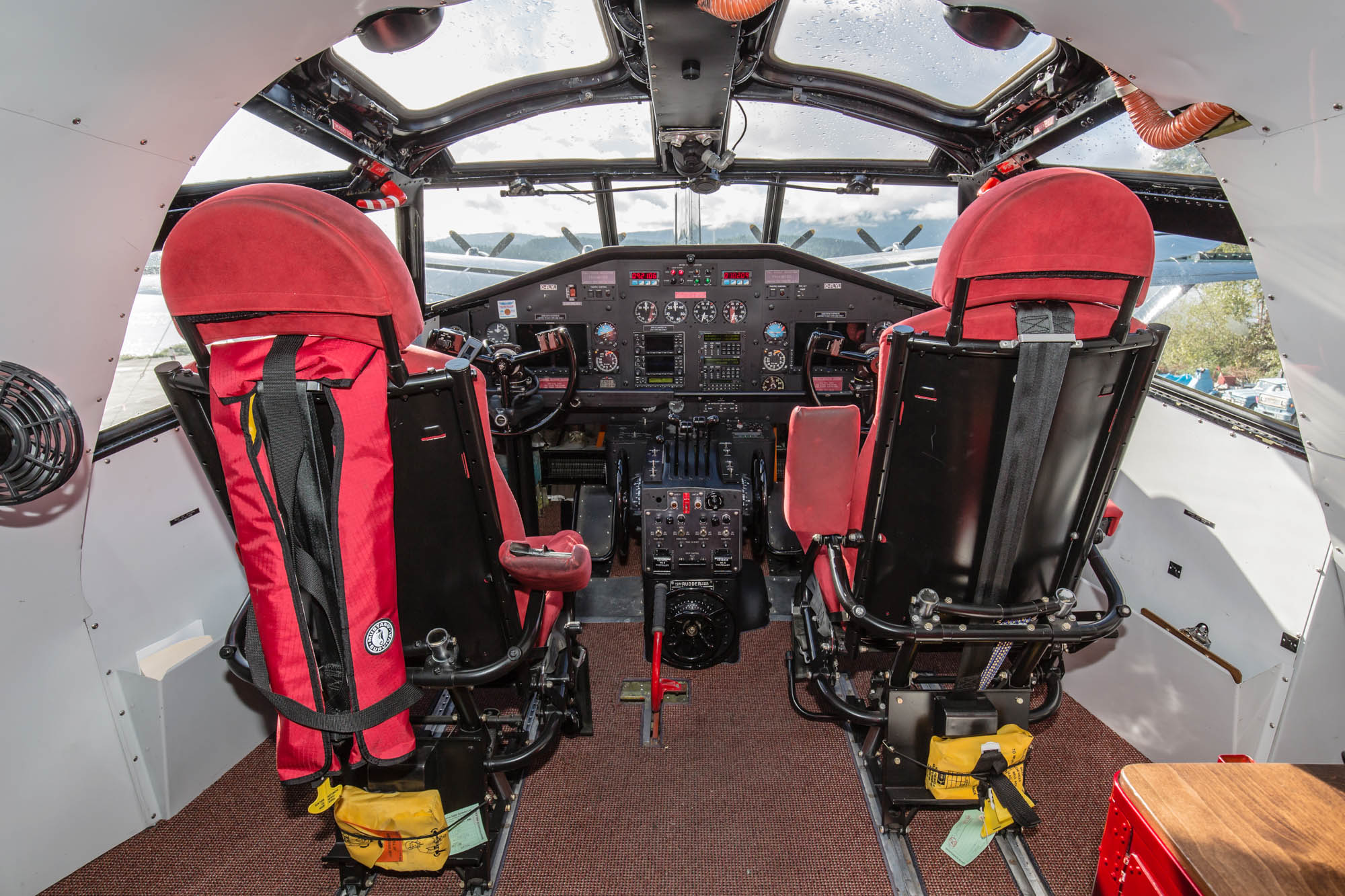 |
| The updated cockpit of Hawaii Mars, if there is an electrical or hydraulic failure then the water can be released using the manual 'hand brake' like mechanism on the floor as shown above. |
| Left to right: The flight engineer's panel and the view downstairs looking forward and to the rear of the aircraft. |
| Philippine Mars has been kept in good order, ready to fly since 2012. It is due to leave Sproat Lake in April 2016. |
| Left to right: Philippine Mars. |
| Left to right: Philippine Mars. |
| Left to right: The Philippine Mars and the Hawaii Mars looking towards Sproat Lake. |
